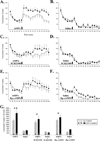Transient viral-mediated overexpression of alpha-calcium/calmodulin-dependent protein kinase II in the nucleus accumbens shell leads to long-lasting functional upregulation of alpha-amino-3-hydroxyl-5-methyl-4-isoxazole-propionate receptors: dopamine type-1 receptor and protein kinase A dependence
- PMID: 20345911
- PMCID: PMC3534927
- DOI: 10.1111/j.1460-9568.2010.07155.x
Transient viral-mediated overexpression of alpha-calcium/calmodulin-dependent protein kinase II in the nucleus accumbens shell leads to long-lasting functional upregulation of alpha-amino-3-hydroxyl-5-methyl-4-isoxazole-propionate receptors: dopamine type-1 receptor and protein kinase A dependence
Abstract
Calcium/calmodulin-dependent protein kinase II (CaMKII) activity is necessary for the long-lasting expression of locomotor sensitization and enhanced drug-taking observed in rats previously exposed to psychostimulants. Exposure to these drugs also transiently increases alphaCaMKII levels in the nucleus accumbens (NAcc), an effect that, when mimicked by transient viral-mediated overexpression of alphaCaMKII in NAcc shell neurons, leads to long-lasting enhancement in locomotor responding to amphetamine and NAcc alpha-amino-3-hydroxyl-5-methyl-4-isoxazole-propionate (AMPA). The present experiments characterized the dopamine (DA) dependence of the functional AMPA receptor upregulation observed long after transient overexpression of alphaCaMKII. Rats infected with herpes simplex virus-alphaCaMKII in the NAcc shell showed a transient increase in alphaCaMKII levels that peaked at 4 days post-infection and returned to baseline 8 days later. When challenged with AMPA (0.8 nmol/side) in the NAcc shell at 20 days post-infection, these rats showed enhanced locomotion compared with controls. This sensitized locomotor response was blocked when AMPA was coinfused with either the DA type-1 receptor antagonist SCH23390 (0.8 nmol/side) or the protein kinase A inhibitor Rp-cAMPS (80 nmol/side). Neither SCH23390 nor Rp-cAMPS produced locomotor effects when infused by itself into the NAcc shell. Furthermore, these antagonists did not block the acute non-sensitized locomotor response to AMPA observed in control rats. These findings show that transient viral-mediated overexpression of alphaCaMKII in neurons of the NAcc shell leads to long-lasting functional upregulation of AMPA receptors that is DA type-1 receptor and protein kinase A dependent. Thus, transient increases in levels of alphaCaMKII in the NAcc shell produce long-lasting changes in the way that DA and glutamate interact in this site to generate locomotor behavior.
Figures



Similar articles
-
Transient overexpression of alpha-Ca2+/calmodulin-dependent protein kinase II in the nucleus accumbens shell enhances behavioral responding to amphetamine.J Neurosci. 2010 Jan 20;30(3):939-49. doi: 10.1523/JNEUROSCI.4383-09.2010. J Neurosci. 2010. PMID: 20089902 Free PMC article.
-
Previous exposure to amphetamine enhances the subsequent locomotor response to a D1 dopamine receptor agonist when glutamate reuptake is inhibited.J Neurosci. 2001 Mar 1;21(5):RC133. doi: 10.1523/JNEUROSCI.21-05-j0003.2001. J Neurosci. 2001. PMID: 11222671 Free PMC article.
-
AMPA receptor upregulation in the nucleus accumbens shell of cocaine-sensitized rats depends upon S-nitrosylation of stargazin.Neuropharmacology. 2014 Feb;77:28-38. doi: 10.1016/j.neuropharm.2013.08.036. Epub 2013 Sep 10. Neuropharmacology. 2014. PMID: 24035918 Free PMC article.
-
Maladaptive consequences of repeated intermittent exposure to uncertainty.Prog Neuropsychopharmacol Biol Psychiatry. 2020 Apr 20;99:109864. doi: 10.1016/j.pnpbp.2020.109864. Epub 2020 Jan 15. Prog Neuropsychopharmacol Biol Psychiatry. 2020. PMID: 31952958 Free PMC article. Review.
-
Homeostatic regulation of reward via synaptic insertion of calcium-permeable AMPA receptors in nucleus accumbens.Physiol Behav. 2020 May 15;219:112850. doi: 10.1016/j.physbeh.2020.112850. Epub 2020 Feb 21. Physiol Behav. 2020. PMID: 32092445 Free PMC article. Review.
Cited by
-
AMPAR-independent effect of striatal αCaMKII promotes the sensitization of cocaine reward.J Neurosci. 2012 May 9;32(19):6578-86. doi: 10.1523/JNEUROSCI.6391-11.2012. J Neurosci. 2012. PMID: 22573680 Free PMC article.
-
The ugly side of amphetamines: short- and long-term toxicity of 3,4-methylenedioxymethamphetamine (MDMA, 'Ecstasy'), methamphetamine and D-amphetamine.Biol Chem. 2011 Jan;392(1-2):103-15. doi: 10.1515/BC.2011.016. Biol Chem. 2011. PMID: 21194370 Free PMC article. Review.
-
Behavioral and structural responses to chronic cocaine require a feedforward loop involving ΔFosB and calcium/calmodulin-dependent protein kinase II in the nucleus accumbens shell.J Neurosci. 2013 Mar 6;33(10):4295-307. doi: 10.1523/JNEUROSCI.5192-12.2013. J Neurosci. 2013. PMID: 23467346 Free PMC article.
-
Alterations in AMPA receptor subunits and TARPs in the rat nucleus accumbens related to the formation of Ca²⁺-permeable AMPA receptors during the incubation of cocaine craving.Neuropharmacology. 2011 Dec;61(7):1141-51. doi: 10.1016/j.neuropharm.2011.01.021. Epub 2011 Jan 27. Neuropharmacology. 2011. PMID: 21276808 Free PMC article.
-
Threonine 149 phosphorylation enhances ΔFosB transcriptional activity to control psychomotor responses to cocaine.J Neurosci. 2014 Aug 20;34(34):11461-9. doi: 10.1523/JNEUROSCI.1611-14.2014. J Neurosci. 2014. PMID: 25143625 Free PMC article.
References
-
- Anderson SM, Famous KR, Sadri-Vakili G, Kumaresan V, Schmidt HD, Bass CE, Terwilliger EF, Cha JJ, Pierce RC. CaMKII: a biochemical bridge linking accumbens dopamine and glutamate systems in cocaine seeking. Nat. Neurosci. 2008;11:344–353. - PubMed
-
- Barria A, Derkach V, Soderling T. Identification of the Ca2+/calmodulin-dependent protein kinase II regulatory phosphorylation site in the alpha-amino-3-hydroxyl-5-methyl-4-isoxazole-propinate-typeglutamate receptor. J. Biol. Chem. 1997;272:32727–32730. - PubMed
-
- Bell K, Duffy P, Kalivas PW. Context-specific enhancement of glutamate transmission by cocaine. Neuropsychopharmacology. 2000;23:335–344. - PubMed
-
- Bennett MK, Erondu NE, Kennedy MB. Purification and characterization of a calmodulin-dependent protein kinase that is highly concentrated in brain. J. Biol. Chem. 1983;258:12735–12744. - PubMed
Publication types
MeSH terms
Substances
Grants and funding
LinkOut - more resources
Full Text Sources

